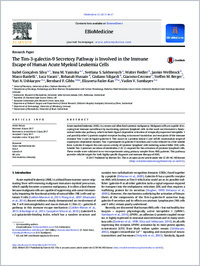The tim-3-galectin-9 secretory pathway is involved in the immune escape of human acute myeloid leukemia cells
- Gonçalves Silva, Isabel School of Pharmacy, University of Kent, Chatham Maritime, UK
- Yasinska, Inna M. School of Pharmacy, University of Kent, Chatham Maritime, UK
- Sakhnevych, Svetlana S. School of Pharmacy, University of Kent, Chatham Maritime, UK
- Fiedler, Walter Department of Oncology, Hematology and Bone Marrow Transplantation with Section Pneumology, Hubertus Wald University Cancer Center, University Medical Center Hamburg-Eppendorf, Germany
- Wellbrock, Jasmin Department of Oncology, Hematology and Bone Marrow Transplantation with Section Pneumology, Hubertus Wald University Cancer Center, University Medical Center Hamburg-Eppendorf, Germany
- Bardelli, Marco Institute for Research in Biomedicine (IRB), Faculty of Biomedical Sciences, Università della Svizzera italiana, Switzerland
- Varani, Luca Institute for Research in Biomedicine (IRB), Faculty of Biomedical Sciences, Università della Svizzera italiana, Switzerland
- Hussain, Rohanah Beamline 23, Diamond Light Source, Didcot, UK
- Siligardi, Giulio Beamline 23, Diamond Light Source, Didcot, UK
- Ceccone, Giacomo European Commission Joint Research Centre, Ispra, Italy
- Berger, Steffen M. Department of Pediatric Surgery and Department of Clinical Research, Children's Hospital, Inselspital, University of Bern, Switzerland
- Ushkaryov, Yuri A. School of Pharmacy, University of Kent, Chatham Maritime, UK
- Gibbs, Bernhard F. School of Pharmacy, University of Kent, Chatham Maritime, UK - Department of Dermatology, University of Oldenburg, Germany
- Fasler-Kan, Elizaveta Department of Pediatric Surgery and Department of Clinical Research, Children's Hospital, Inselspital, University of Bern, Switzerland - Department of Biomedicine, University of Basel, Switzerland
- Sumbayev, Vadim V. School of Pharmacy, University of Kent, Chatham Maritime, UK
-
19.07.2017
Published in:
- Ebiomedicine. - 2017, vol. 22, p. 44-57
English
Acute myeloid leukemia (AML) is a severe and often fatal systemic malignancy. Malignant cells are capable of escaping host immune surveillance by inactivating cytotoxic lymphoid cells. In this work we discovered a fundamental molecular pathway, which includes ligand-dependent activation of ectopically expressed latrophilin 1 and possibly other G-protein coupled receptors leading to increased translation and exocytosis of the immune receptor Tim-3 and its ligand galectin-9. This occurs in a protein kinase C and mTOR (mammalian target of rapamycin)-dependent manner. Tim-3 participates in galectin-9 secretion and is also released in a free soluble form. Galectin-9 impairs the anti-cancer activity of cytotoxic lymphoid cells including natural killer (NK) cells. Soluble Tim-3 prevents secretion of interleukin-2 (IL-2) required for the activation of cytotoxic lymphoid cells. These results were validated in ex vivo experiments using primary samples from AML patients. This pathway provides reliable targets for both highly specific diagnosis and immune therapy of AML.
- Language
-
- English
- Classification
- Medicine
- License
- Open access status
- gold
- Identifiers
-
- RERO DOC 327081
- DOI 10.1016/j.ebiom.2017.07.018
- ARK ark:/12658/srd1319087
- Persistent URL
- https://n2t.net/ark:/12658/srd1319087
Statistics
Document views: 199
File downloads:
- Texte intégral: 288
